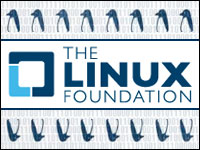
The Linux Foundation last week announced it was teaming up with a group of high-tech and financial giants on a project to advance the blockchain technology made famous by bitcoin virtual currency.
IBM, Cisco and Intel have agreed to collaborate with financial institutions including startup R3 CEV, the London Stock Exchange Group, J.P. Morgan, Wells Fargo, the Deutsche Bourse and ANZ Bank to develop an enterprise-grade open source distributed ledger framework. Other companies joining the effort include Accenture and Digital Asset Holdings.
R3, which will contribute a new financial transaction architectural framework, is developing common standards for block technology for 42 banks, including JP Morgan, Credit Suisse and Goldman Sachs.
IBM will contribute tens of thousands of lines of code and corresponding intellectual property.
The project will be known as “Hyperledger,” a trademark owned by Digital Access Holdings, which in June bought the team that created the award-winning Hyperledger distributed ledger platform.
Why Blockchain?
Blockchain “strives to provide a standard platform for financial transactions ranging from volume e-commerce to full-blown currency and equity exchange infrastructure,” commented Bill Weinberg, principal analyst at Linux Pundit.
“The Linux Foundation is uniquely well-positioned to establish such a de facto standard and to foster shared, open source implementation with more agility and velocity than either individual financial institutions or de jure standards bodies,” he told LinuxInsider.
While banks and financial institutions have been among the first to consider blockchain, according to IBM Middleware CTO Jerry Cuomo, “the real opportunity for this emerging technology lies in other areas far beyond the financial industry.”
Blockchain in Brief
Blockchain is essentially a digital technology for recording and verifying transactions. It’s a distributed database of transactional data that can’t be tampered with or revised — even by the data store’s operators — because a timestamp server batches recent transactions into blocks and timestamps a hash of each block.
Each block’s timestamp includes the prior timestamp, forming a chain.
Blockchains use peer-to-peer architecture.
One advantage of blockchain tech is that several nodes can converge on one consensus of the most up-to-date version of a large data set, even if the operators should be dishonest or malicious, or if the nodes should operate anonymously or have poor connectivity with one another.
The blockchain architecture provides reassurance that transactions nodes create are valid, have taken place and have become final. With blockchain, trying to rewrite or alter transaction history is prohibitively expensive, and automated resolution ensures that conflicting transactions — such as two or more attempts to spend the same money in different places — don’t become part of the confirmed dataset.
Possible Blockchain Opportunities
“Some of the most intriguing blockchain applications are in the area of IoT, where blockchain could be used in consumer products that have awareness to sense and respond,” IBM’s Cuomo told LinuxInsider. For example, data from an insulin pump potentially could be sent to a device maker and physicians, and securely shared and encrypted over blockchain.
“We’re also excited about how blockchain could help companies improve their supply chain or even prove the provenance of parts in the event of a product recall,” Cuomo continued.
In fact, blockchain “can be used to record virtually anything of value — your identity, a will, a deed, or almost any type of secure transfer of information,” he said.
The Joys of Going Open
An open source implementation “helps to inculcate acceptance of de facto standardization,” observed Linux Pundit’s Weinberg, which will free up enterprises “to build value-added applications on top of blockchain, instead of continually reimplementing financial infrastructure and creating and corralling ecosystems to adopt and support it.”
For financial services infrastructure, “visibility into source code provides adopters with assurances of better security through shared security,” he said.
Developers will be moved higher in the stack and “offered freedom to innovate,” Weinberg suggested. They’ll have “new opportunities to add value instead of reinventing shared underlying functionality.”





















































